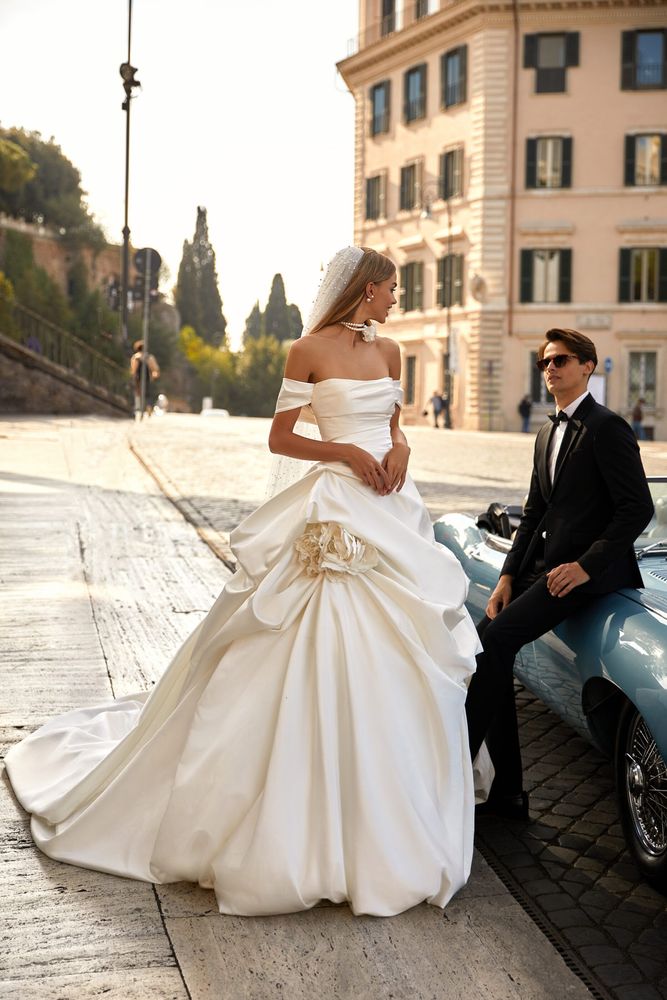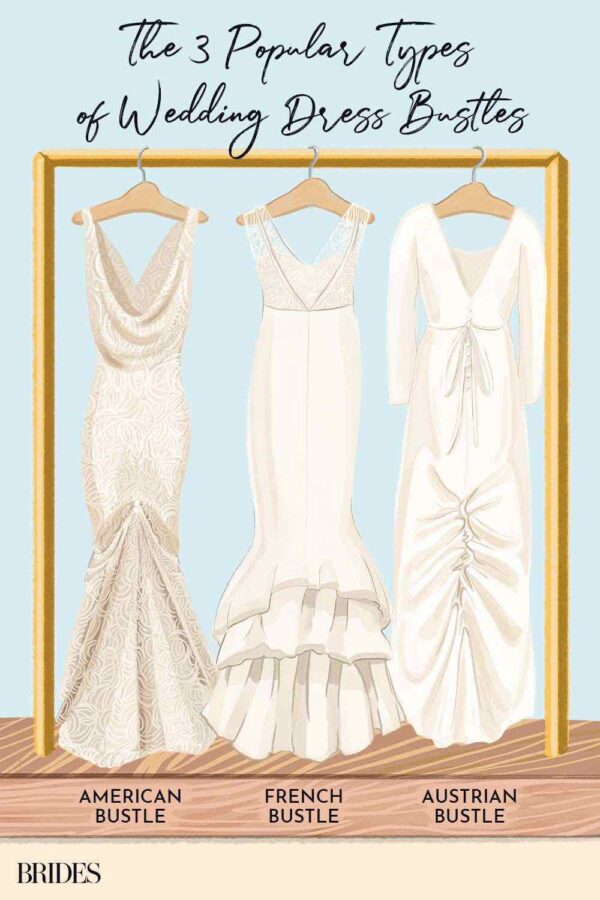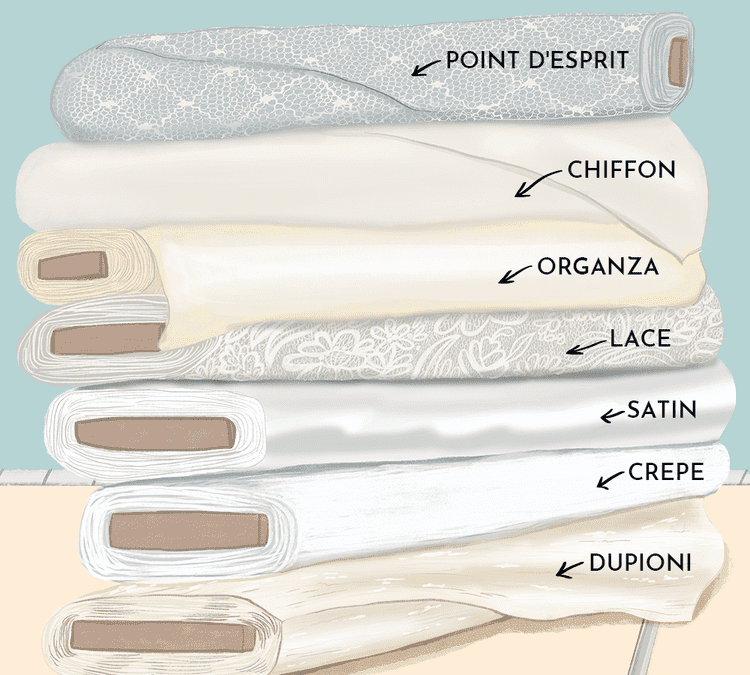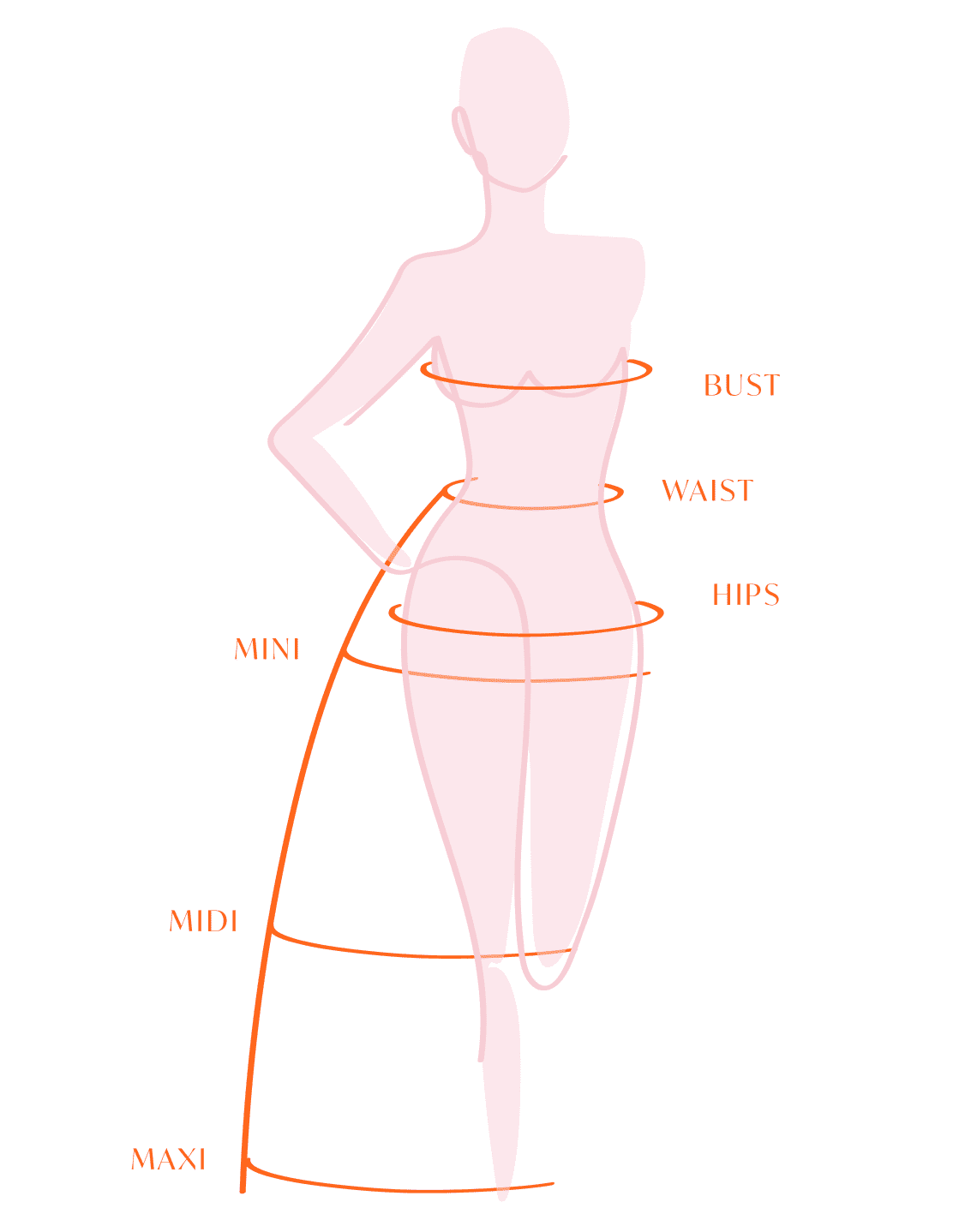
A timeless Bridal Look for Your Wedding Day
December 1, 2022
Trains and How-to-Bustle Them
January 21, 2023A Guide to Your Perfect Dress Fabric
Shopping for your dream wedding dress is an exciting experience, but it can also be an intimidating one. There are a plethora factors to consider when choosing your gown, like which fabric drapes flawlessly off your shoulders, and which shade of white complements your unique skin tone best. This guide will help you narrow down which styles are right for you.
The choice of fabric determines the style and silhouette of the dress, whether its structural or flowing, lustrous or matte, architectural or romantic, it is crucial for your comfort and price range.
Brocade is an excellent choice for a structured, formal gown in the wintry weather seasons. It is quite a heavy fabric with raised designs woven into the fabric. For a more lightweight alternative you can opt for Damask or Jacquard.
Charmeuse is a lightweight satin with a glossy appearance, perfect for that slinky, sexy summer dress. It is typically the fabric you would find in lingerie or nightgowns.
Chiffon is the go-to for any boho bride, it is a sheer and airy fabric with an ethereal vibe, fitting for an outdoor wedding. Although it is a very delicate fabric.
A year-round favorite fabric for wedding gowns is Crepe. Crepe is a classic choice that will accentuate your curves in a range of styles like mermaid or A-line. Its pebbled texture is lightweight and made of silk or wool, suitable for most soft silhouettes.
Double-faced satin is a couture fabric with a sheen on both sides. It is a heavyweight material used for more structural styles.
Duchess satin is a popular choice for high- end designers and characterized by a soft luster appearance. It can be made from a variety of textiles like silk, rayon, or a blend.
Douppioni silk is a full-bodied silk made for ballgowns because it holds its shape very well. It is a more affordable fabric with a naturally wavy pattern and comes in several colors- ideal for both brides and bridesmaids.
Made from silk, cotton, or rayon, Faille is popular in winter and tends to appear in more structured, modern styles. Its finely ribbed with a crosswise rib effect.
The nude, mesh fabric you find often attached to lace on the bodice of the gown or as sleeves, is Illusion fabric. It is perfect for giving that sheer effect and helps add elegant details to elevate your gown.
If you’re looking for a whimsical, fantasy gown, opt for Organza. This romantic fabric is semi sheer and stiff, holding larger ballgown shapes very well. It can also add fullness to a gown or veil without increasing the weight. Organza is a very delicate fabric as it can snag easily.
Shantung serves as a lightweight alternative to douppioni silk with a beautiful, light-catching glimmer. The texture is rubbed and irregular giving a very raw or natural look to the dress. It holds well for structured styles while also draping elegantly over any figure.
Taffeta, made from silk or polyester, is a crisp woven fabric with an iridescence. Either draped, or structured, it makes for the perfect A-line dress.
Tulle is what you will find in a veil or a ballerina’s tutu, it is a sheer gauzy fabric used to add texture and structure to a gown. This lightweight, fine fabric is worn all year round, but be careful as it can tear easily or shred up your hosiery.
Now that you have chosen a fabric, or at least narrowed down your options, let’s talk about the different shades they come in. White is the classic choice for a traditional bride, but women today will opt for creamier more subtle shades that complement their undertones.
First, we can start with the benefits of a pure white dress. It is a tricky shade to pull off, although it can be very flattering on brides with cool undertones or deeper skin tones. If your skin is very fair with yellow undertones it may be best to avoid a stark white.
Ivory is a popular choice and flattering on most women. Alternatively, to the pure white, ivory can aid in warming up your skin and is the optimal choice for a fair bride.
Champagne is even creamier than ivory and can almost appear beige. Champagne is most suitable for women with warm undertones, olive skin, and fair skin. It is an excellent choice for older brides as it exudes sophistication.
Pale pink or rum can be flattering on all brides, although women with warm undertones or olive skin may have trouble finding the right shade.
Shopping for your dream wedding dress is an exciting experience, but it can also be an intimidating one. There are a plethora factors to consider when choosing your gown, like which fabric drapes flawlessly off your shoulders, and which shade of white complements your unique skin tone best. This guide will help you narrow down which styles are right for you.
The choice of fabric determines the style and silhouette of the dress, whether its structural or flowing, lustrous or matte, architectural or romantic, it is crucial for your comfort and price range.
Brocade is an excellent choice for a structured, formal gown in the wintry weather seasons. It is quite a heavy fabric with raised designs woven into the fabric. For a more lightweight alternative you can opt for Damask or Jacquard.
Charmeuse is a lightweight satin with a glossy appearance, perfect for that slinky, sexy summer dress. It is typically the fabric you would find in lingerie or nightgowns.
Chiffon is the go-to for any boho bride, it is a sheer and airy fabric with an ethereal vibe, fitting for an outdoor wedding. Although it is a very delicate fabric.
A year-round favorite fabric for wedding gowns is Crepe. Crepe is a classic choice that will accentuate your curves in a range of styles like mermaid or A-line. Its pebbled texture is lightweight and made of silk or wool, suitable for most soft silhouettes.
Double-faced satin is a couture fabric with a sheen on both sides. It is a heavyweight material used for more structural styles.
Duchess satin is a popular choice for high- end designers and characterized by a soft luster appearance. It can be made from a variety of textiles like silk, rayon, or a blend.
Douppioni silk is a full-bodied silk made for ballgowns because it holds its shape very well. It is a more affordable fabric with a naturally wavy pattern and comes in several colors- ideal for both brides and bridesmaids.
Made from silk, cotton, or rayon, Faille is popular in winter and tends to appear in more structured, modern styles. Its finely ribbed with a crosswise rib effect.
The nude, mesh fabric you find often attached to lace on the bodice of the gown or as sleeves, is Illusion fabric. It is perfect for giving that sheer effect and helps add elegant details to elevate your gown.
If you’re looking for a whimsical, fantasy gown, opt for Organza. This romantic fabric is semi sheer and stiff, holding larger ballgown shapes very well. It can also add fullness to a gown or veil without increasing the weight. Organza is a very delicate fabric as it can snag easily.
Shantung serves as a lightweight alternative to douppioni silk with a beautiful, light-catching glimmer. The texture is rubbed and irregular giving a very raw or natural look to the dress. It holds well for structured styles while also draping elegantly over any figure.
Taffeta, made from silk or polyester, is a crisp woven fabric with an iridescence. Either draped, or structured, it makes for the perfect A-line dress.
Tulle is what you will find in a veil or a ballerina’s tutu, it is a sheer gauzy fabric used to add texture and structure to a gown. This lightweight, fine fabric is worn all year round, but be careful as it can tear easily or shred up your hosiery.
Now that you have chosen a fabric, or at least narrowed down your options, let’s talk about the different shades they come in. White is the classic choice for a traditional bride, but women today will opt for creamier more subtle shades that complement their undertones.
First, we can start with the benefits of a pure white dress. It is a tricky shade to pull off, although it can be very flattering on brides with cool undertones or deeper skin tones. If your skin is very fair with yellow undertones it may be best to avoid a stark white.
Ivory is a popular choice and flattering on most women. Alternatively, to the pure white, ivory can aid in warming up your skin and is the optimal choice for a fair bride.
Champagne is even creamier than ivory and can almost appear beige. Champagne is most suitable for women with warm undertones, olive skin, and fair skin. It is an excellent choice for older brides as it exudes sophistication.
Pale pink or rum can be flattering on all brides, although women with warm undertones or olive skin may have trouble finding the right shade.

Shopping for your dream wedding dress is an exciting experience, but it can also be an intimidating one. There are a plethora factors to consider when choosing your gown, like which fabric drapes flawlessly off your shoulders, and which shade of white complements your unique skin tone best. This guide will help you narrow down which styles are right for you.
The choice of fabric determines the style and silhouette of the dress, whether its structural or flowing, lustrous or matte, architectural or romantic, it is crucial for your comfort and price range.
Brocade is an excellent choice for a structured, formal gown in the wintry weather seasons. It is quite a heavy fabric with raised designs woven into the fabric. For a more lightweight alternative you can opt for Damask or Jacquard.
Charmeuse is a lightweight satin with a glossy appearance, perfect for that slinky, sexy summer dress. It is typically the fabric you would find in lingerie or nightgowns.
Chiffon is the go-to for any boho bride, it is a sheer and airy fabric with an ethereal vibe, fitting for an outdoor wedding. Although it is a very delicate fabric.
A year-round favorite fabric for wedding gowns is Crepe. Crepe is a classic choice that will accentuate your curves in a range of styles like mermaid or A-line. Its pebbled texture is lightweight and made of silk or wool, suitable for most soft silhouettes.
Double-faced satin is a couture fabric with a sheen on both sides. It is a heavyweight material used for more structural styles.
Duchess satin is a popular choice for high- end designers and characterized by a soft luster appearance. It can be made from a variety of textiles like silk, rayon, or a blend.
Douppioni silk is a full-bodied silk made for ballgowns because it holds its shape very well. It is a more affordable fabric with a naturally wavy pattern and comes in several colors- ideal for both brides and bridesmaids.
Made from silk, cotton, or rayon, Faille is popular in winter and tends to appear in more structured, modern styles. Its finely ribbed with a crosswise rib effect.
The nude, mesh fabric you find often attached to lace on the bodice of the gown or as sleeves, is Illusion fabric. It is perfect for giving that sheer effect and helps add elegant details to elevate your gown.
If you’re looking for a whimsical, fantasy gown, opt for Organza. This romantic fabric is semi sheer and stiff, holding larger ballgown shapes very well. It can also add fullness to a gown or veil without increasing the weight. Organza is a very delicate fabric as it can snag easily.
Shantung serves as a lightweight alternative to douppioni silk with a beautiful, light-catching glimmer. The texture is rubbed and irregular giving a very raw or natural look to the dress. It holds well for structured styles while also draping elegantly over any figure.
Taffeta, made from silk or polyester, is a crisp woven fabric with an iridescence. Either draped, or structured, it makes for the perfect A-line dress.
Tulle is what you will find in a veil or a ballerina’s tutu, it is a sheer gauzy fabric used to add texture and structure to a gown. This lightweight, fine fabric is worn all year round, but be careful as it can tear easily or shred up your hosiery.
Now that you have chosen a fabric, or at least narrowed down your options, let’s talk about the different shades they come in. White is the classic choice for a traditional bride, but women today will opt for creamier more subtle shades that complement their undertones.
First, we can start with the benefits of a pure white dress. It is a tricky shade to pull off, although it can be very flattering on brides with cool undertones or deeper skin tones. If your skin is very fair with yellow undertones it may be best to avoid a stark white.
Ivory is a popular choice and flattering on most women. Alternatively, to the pure white, ivory can aid in warming up your skin and is the optimal choice for a fair bride.
Champagne is even creamier than ivory and can almost appear beige. Champagne is most suitable for women with warm undertones, olive skin, and fair skin. It is an excellent choice for older brides as it exudes sophistication.
Pale pink or rum can be flattering on all brides, although women with warm undertones or olive skin may have trouble finding the right shade.
Shopping for your dream wedding dress is an exciting experience, but it can also be an intimidating one. There are a plethora factors to consider when choosing your gown, like which fabric drapes flawlessly off your shoulders, and which shade of white complements your unique skin tone best. This guide will help you narrow down which styles are right for you.
The choice of fabric determines the style and silhouette of the dress, whether its structural or flowing, lustrous or matte, architectural or romantic, it is crucial for your comfort and price range.
Brocade is an excellent choice for a structured, formal gown in the wintry weather seasons. It is quite a heavy fabric with raised designs woven into the fabric. For a more lightweight alternative you can opt for Damask or Jacquard.
Charmeuse is a lightweight satin with a glossy appearance, perfect for that slinky, sexy summer dress. It is typically the fabric you would find in lingerie or nightgowns.
Chiffon is the go-to for any boho bride, it is a sheer and airy fabric with an ethereal vibe, fitting for an outdoor wedding. Although it is a very delicate fabric.
A year-round favorite fabric for wedding gowns is Crepe. Crepe is a classic choice that will accentuate your curves in a range of styles like mermaid or A-line. Its pebbled texture is lightweight and made of silk or wool, suitable for most soft silhouettes.
Double-faced satin is a couture fabric with a sheen on both sides. It is a heavyweight material used for more structural styles.
Duchess satin is a popular choice for high- end designers and characterized by a soft luster appearance. It can be made from a variety of textiles like silk, rayon, or a blend.
Douppioni silk is a full-bodied silk made for ballgowns because it holds its shape very well. It is a more affordable fabric with a naturally wavy pattern and comes in several colors- ideal for both brides and bridesmaids.
Made from silk, cotton, or rayon, Faille is popular in winter and tends to appear in more structured, modern styles. Its finely ribbed with a crosswise rib effect.
The nude, mesh fabric you find often attached to lace on the bodice of the gown or as sleeves, is Illusion fabric. It is perfect for giving that sheer effect and helps add elegant details to elevate your gown.
If you’re looking for a whimsical, fantasy gown, opt for Organza. This romantic fabric is semi sheer and stiff, holding larger ballgown shapes very well. It can also add fullness to a gown or veil without increasing the weight. Organza is a very delicate fabric as it can snag easily.
Shantung serves as a lightweight alternative to douppioni silk with a beautiful, light-catching glimmer. The texture is rubbed and irregular giving a very raw or natural look to the dress. It holds well for structured styles while also draping elegantly over any figure.
Taffeta, made from silk or polyester, is a crisp woven fabric with an iridescence. Either draped, or structured, it makes for the perfect A-line dress.
Tulle is what you will find in a veil or a ballerina’s tutu, it is a sheer gauzy fabric used to add texture and structure to a gown. This lightweight, fine fabric is worn all year round, but be careful as it can tear easily or shred up your hosiery.
Now that you have chosen a fabric, or at least narrowed down your options, let’s talk about the different shades they come in. White is the classic choice for a traditional bride, but women today will opt for creamier more subtle shades that complement their undertones.
First, we can start with the benefits of a pure white dress. It is a tricky shade to pull off, although it can be very flattering on brides with cool undertones or deeper skin tones. If your skin is very fair with yellow undertones it may be best to avoid a stark white.
Ivory is a popular choice and flattering on most women. Alternatively, to the pure white, ivory can aid in warming up your skin and is the optimal choice for a fair bride.
Champagne is even creamier than ivory and can almost appear beige. Champagne is most suitable for women with warm undertones, olive skin, and fair skin. It is an excellent choice for older brides as it exudes sophistication.
Pale pink or rum can be flattering on all brides, although women with warm undertones or olive skin may have trouble finding the right shade.




